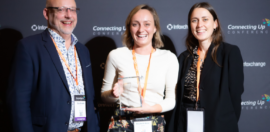The Dawning of the Age of Disruption
26 March 2015 at 10:40 am
Once understood, the threat of disruptive technological change can be turned into a huge competitive advantage. Even resource-starved Not for Profits organisations can ride the wave, writes Tania de Jong AM as she reflects on this week’s Creative Innovation 2015 Conference.
The only constant in this world is change.
 That’s what one of world’s outstanding leaders and executive Chairman of the X PRIZE Foundation, Dr Peter Diamandis and world-leading experts and futurists reminded us at this week’s Creative Innovation 2015 Conference.
That’s what one of world’s outstanding leaders and executive Chairman of the X PRIZE Foundation, Dr Peter Diamandis and world-leading experts and futurists reminded us at this week’s Creative Innovation 2015 Conference.
In a packed program, Dr Diamandis was just one presenter challenging participants to think about the future, and what an exponential explosion of technological innovation means for our economy, society and for each and every one of us as individuals.
If Ci2015 experts have it right, in even ten years’ time we’ll not only be riding in driverless cars, but we’ll be looking at a world where machines are not just things but living entities with artificial intelligence starting to rival flesh and blood people. Dr Diamandis pointed out that in a few short years another five billion people will have been connected to the Internet, teeming with new ideas, insights and ways of doing things.
Just think back a decade. Who then had heard of Facebook or could have anticipated that cute cat videos could captivate the entire world through YouTube? Who then would have believed that their mobile phone would become the way that most of us would take our happy snaps and transform our culture, and the way the world sees us, through the phenomenon of the selfie?
Indeed, in 2005 digital cameras themselves had just supplanted the film technology that had endured for over 150 years! In three years, will smartphones themselves be oh, so yesterday?
And talking of that, where is Kodak, the company that in the 1880s popularised photography for the masses? It was destroyed by the very digital technology it invented yet failed to see its own technology’s potential to make its film-based business obsolete. After all, Kodak made its money selling 36 exposure films to punters who might only get one good photo!
Speaker after speaker at Ci2015 drove home the message that large-scale disruption caused by the internet, technology, robotics and globalisation is the greatest threat to organisations and government in the next five years. But as CEO of ANZ Global Wealth, Joyce Phillips, pointed out, change and innovation also bring great opportunity.
And even the more successful riders of change sometimes miss opportunities too. Nolan Bushnell, founder of Atari, told the Conference how in the 1970s he was given the chance by one of his former employees, a bloke he described as intense and prickly, to have a one-third stake of a new start-up company for just $50,000.
The company’s name was Apple. The employee’s name was Steve Jobs.
Mass disruption is undoubtedly the greatest commercial and cultural threat all organisations will face in the foreseeable future. But since the start of the Industrial Revolution we’ve lived with it, we’ve coped with it, we’ve adapted to it. Disruption has helped make us what we are.
Once understood, the threat of disruptive change from outside can be turned to a huge competitive advantage. Speakers at Ci2015 showed how that can be done, and how even resource-starved organisations always living on the financial edge, not least Not for Profits, to ride the wave.
It is critical for us to do some serious crystal ball gazing to work out what we as societies, organisations and individuals need to manage galloping disruption and opportunities. Ci2015 gathered in Melbourne some of the best minds in the world to apply their experience, expertise and insights to how we, as a global community, can make a manageable transition from a state of continuous disruption to a state of sustainable growth.
It can be done, and together we will do it.
About the author: Tania de Jong is a soprano, creative innovation catalyst, entrepreneur and founder of Creative Innovation 2015 Asia Pacific “From disruption to sustainable growth” in Melbourne, at which more than 40 of the world’s leading thinkers, futurists, disruptors and technology experts took part with an audience of 800 leaders and emerging leaders from across diverse sectors. www.ci2015.com.au www.creativeuniverse.com.au









The share in the article will be helpful to people when looking at this article